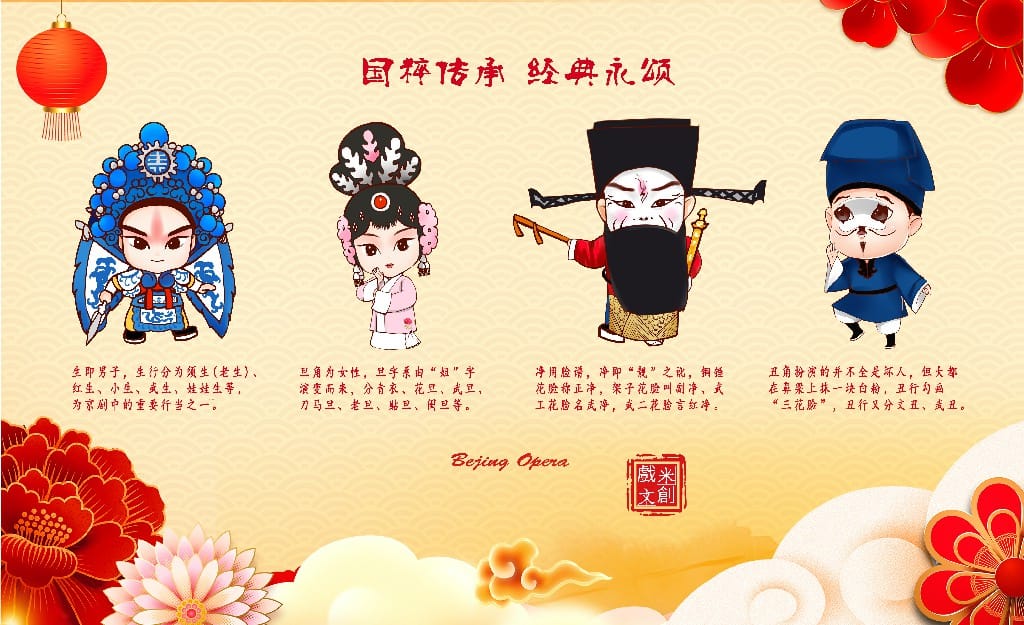Peking Opera costumes, known as xingtou (行头) or juzhuang (剧装), are elaborate, colorful, and highly symbolic, designed to reflect the character's role, status, personality, and historical context. They are an essential part of Peking Opera's visual and artistic expression. Below is an overview of the costumes used in Peking Opera:
1. Key Characteristics of Peking Opera Costumes
- Vibrant Colors: Colors carry symbolic meanings:
- Red: Loyalty, bravery, or heroism.
- Black: Integrity, boldness, or impartiality.
- White: Treachery, cunning, or villainy.
- Yellow: Royalty or high nobility (often reserved for emperors).
- Blue: Courage or high-ranking military roles.
- Green: Supernatural beings or secondary characters.
- Exaggerated Designs: Costumes are larger-than-life, with wide sleeves, heavy embroidery, and ornate patterns to enhance stage presence.
- Historical Inspiration: While rooted in Ming and Qing dynasty styles, costumes are stylized rather than historically accurate, emphasizing theatricality.
- Layering: Costumes often include multiple layers, such as robes, vests, and belts, to convey status or role complexity.
2. Main Types of Costumes by Role
Peking Opera categorizes characters into four main roles—Sheng (male), Dan (female), Jing (painted-face male), and Chou (clown)—each with distinct costume styles:
Sheng (Male Roles)
- Mang (蟒): A long, embroidered robe with wide sleeves, worn by emperors, generals, or high-ranking officials. Features dragon or cloud motifs for nobility.
- Kao (靠): A military costume with armor-like padding and flags on the back, worn by warriors or generals. Indicates combat readiness.
- Pi (帔): A formal robe with slanted front, worn by scholars or civil officials.
- Zhezi (褶子): A versatile, pleated robe for everyday male characters, often with a scholarly or casual look.
Dan (Female Roles)
- Nü Mang (女蟒): Similar to the male mang but tailored for female characters, often worn by empresses or noblewomen, with phoenix or floral embroidery.
- Nü Kao (女靠): Female warrior armor, lighter and more delicate than male kao, worn by martial heroines.
- Qipao or Gu Zhuang (旗袍/古装): Elegant, flowing dresses for young women or refined ladies, often with long water sleeves (shuixiu) for expressive movements.
- Yunjian (云肩): Cloud-shaped shoulder ornaments, often worn by young female characters to enhance grace.
Jing (Painted-Face Male Roles)
- Jing Mang or Kao: Heavy, ornate robes or armor, often in bold colors to match the character's painted face, symbolizing strength or ferocity.
- Te Mang (特蟒): Specialized robes for supernatural or mythical characters, with exaggerated patterns like flames or animal motifs.
- Costume Accessories: Jing roles often wear thick-soled boots and bulky padding to appear larger and more imposing.
Chou (Clown Roles)
- Chou Yi (丑衣): Simpler, less ornate clothing, often patched or mismatched to reflect the comedic or lowly status of the character.
- Baoyi (包衣): Short jackets or vests for agile, humorous roles.
- Bright Colors: Chou costumes may use lighter or comical patterns to emphasize their playful nature.
3. Accessories and Details
- Headdresses: Elaborate crowns, helmets, or hairpieces, often adorned with tassels, beads, or feathers. For example:
- Guan (冠): Official hats for nobility.
- Kui (盔): Warrior helmets for martial roles.
- Fenghuang Guan (凤凰冠): Phoenix crowns for female nobility.
- Water Sleeves (Shuixiu): Long, flowing white sleeves used for expressive gestures, especially in Dan roles.
- Belts and Sashes: Ornate belts with jade or metal accents to signify rank.
- Boots: Platform boots (for Jing and Sheng roles) or embroidered shoes (for Dan roles) to enhance stature or elegance.
- Props: Costumes are often paired with props like fans, handkerchiefs, or weapons to complement the character's actions.
4. Cultural and Artistic Significance
- Symbolism: Every element, from color to embroidery, conveys the character’s personality, moral alignment, or social status.
- Movement: Costumes are designed to enhance choreography, with flowing sleeves and layered fabrics accentuating gestures and dances.
- Craftsmanship: Costumes are handcrafted with intricate embroidery, often taking weeks or months to complete, reflecting centuries-old techniques.
5. Modern Adaptations
While traditional Peking Opera costumes remain largely unchanged, some modern productions experiment with simplified designs or contemporary materials to appeal to new audiences. However, the core aesthetic and symbolism are preserved to maintain authenticity.
Conclusion
Peking Opera costumes are a vibrant and integral part of the art form, tailored to each character’s role and status. They combine functionality, symbolism, and artistry to create a visually stunning performance.
